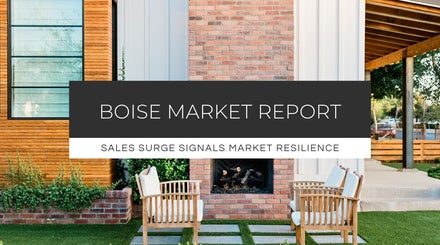
Treasure Valley home price appreciation declined to the lowest in eight years as rising interest rates sent affordability to multidecade lows.
Ada County and Canyon County home prices rose just 1% in the year ending in September—the slowest growth rate since 2014.
The two counties' combined sales declined to 1,043 from last year's 1,543, reflecting a shift in buyer sentiment and reduced affordability from rising rates.
Homebuyers have more choice and negotiating power compared to prior years, but monthly payments can create sticker shock.
The year began with near-record low inventory and years of pent-up demand, but rapidly rising interest rates have changed the equation for many would-be buyers.
Since January, mortgage rates have more than doubled, rising from 3% to nearly 6.7%, the highest level since 2007. The result has been an increase in the cost of a typical mortgage payment by hundreds of dollars a month—despite home prices barely budging.
The sharp rise in rates makes it harder for buyers to qualify for loans. The resulting reduction in demand has given people looking for homes more negotiating power and created a more level playing field with sellers.
Simultaneously, a notable drop-off in resale listings from homeowners reluctant to relinquish rock-bottom rates is helping to control supply.
The number of new listings declined again in September, while months of supply rose slightly to 3 in Ada County and 2.91 in Canyon County. The number of newly listed homes is falling slower than demand—hence the tiny build in supply.
However, at around three months, supply is still well below the four to six months considered a balanced market.
The Treasure Valley housing market has a balanced feel even with a below-normal supply of homes for sale. Sellers don't have the upper hand anymore, as there is a gap between what buyers want and what they're willing and able to pay.
Buyers and sellers may be close to equal footing, but supply and demand can vary from city to city and neighborhood to neighborhood.
Here is the median single-family home price and year-over-year change by area:
- Ada County: $540,000, up $5,050 (0.94%)
- Canyon County: $426,990, up $4,990 (1.18%)
- Boise: $519,800, up $24,800 (5.01%)
- Meridian: $524,900, down $21,100 (-3.86%)
- Eagle: $899,388, up $136,888 (17.95%)
- Nampa: $430,000, up $13,505 (3.24%)
Higher Monthly Payments Due More to Rising Rates Than Prices
People tend to underestimate the effects of mortgage rates on affordability and monthly payments. Even though price gains have slowed to a trickle, affordability has plunged since the beginning of the year.
Before the pandemic began, local housing affordability was higher than in most of the 2000s. Monthly payments in proportion to income weren't cheap but also weren't out of line with their long-term averages.
Since the beginning of the pandemic, rising prices have received most of the blame for the rapid decrease in home affordability. While that's partially true, it's only half the story.
The increase in mortgage rates since the beginning of the year has had a bigger impact on monthly payments than the gain in home prices since October 2020.
There are four main drivers of home price appreciation over the longer term: strength in the local economy, job growth, new household formation, and affordability.
The economy is in excellent shape at the local level, unemployment remains near record lows, and we have had no shortage of people moving to the Treasure Valley.
The primary issue is affordability, and it's a big one. In June, the National Association of Realtors reported that U.S. housing affordability had dropped to the lowest level since 1989.
While part of the decrease since 2019 is due to higher home prices, most of this year's change has been from higher rates.
Supply Remains Low as Home Sellers Pull Back
Despite the shift in demand we've seen in 2022, the supply has remained historically low, almost surprisingly so.
In previous housing slowdowns, mortgage rates were typically declining. This time, with the Fed attempting to fight inflation by raising interest rates, mortgage rates are soaring.
To a homeowner, falling rates make it pretty tempting to "trade up." You can lock in some of your previous home equity gains, get a lower interest rate on a new loan, and find a good deal on a bigger and hopefully better house to boot.
As rates rise, trading up becomes less appealing. Giving up a low rate for a much higher one is proving to be a strong disincentive to move. More homeowners stay put, increasing the shortage of available homes. This trend isn't likely to change anytime soon.
Loan rates aside, there is not a lot of pent-up demand in the Treasure Valley to sell. With ample opportunity over the last ten years, the people that wanted to sell have sold.
A Slowdown in New Construction Risks a Deeper Housing Crisis
New home builders, a group hit particularly hard during the financial crisis of '07–'09, have been particularly jumpy lately. As early as May, we started seeing pullbacks in the construction of new homes, and some builders even started laying off staff.
Rather than being a predictor of the housing market, builder sentiment tends to mirror it. Nationally, builder exuberance peaks when the housing market peaks and hits bottom right before the market tends to take off. Builder sentiment hit an eight-year low in April 2020, just as home prices began one of their quickest surges in history.
Lately, builders have been zigging when they should have been zagging. In 2020, they were preselling homes months before completion and were missing out on big gains. Then, this winter, they were waiting until the last minute to list when they could have been preselling and locking in buyers before higher interest rates sapped demand.
In many ways, these behavior shifts create peaks and valleys in local home prices.
The rush to build new homes when times are good creates price-destroying housing supply bubbles as we saw in the mid-2000s. On the flip side, when sentiment is at its lowest, a drop in new construction and the scarcity of new homes eventually raise prices.
It can take years of planning to get a new home development off the ground. With an existing housing shortage and a pullback in new construction, we may face a deeper home shortage by the beginning of 2024.
The Next Few Months Will Favor Buyers as the Market Continues to Adjust
Undoubtedly, the Treasure Valley housing market looks very different than it did in 2021, but that is not necessarily a bad thing. We are much closer to a "normal" market than we have been in a decade.
We are slowly working through the extremes of the last few years. The result will be a more sustainable and healthy housing market in the long term, but we are not there yet.
As people rethink their priorities, the market is shifting from one of want (or FOMO) to one of necessity.
Homes are still selling, and the most expertly marketed and realistically priced are selling quickly. (We have listings at all price points that are selling in days.)
If rates continue to rise, demand will fall further. If you plan on selling your property in 2023, don't wait until summer—the time to start preparing is now.
Buyers, take advantage of the next few months.
Like fall colors, inventory typically peaks in early October. You may be able to find better prices in November and December, but you will have a little less to choose from. If you are flexible with your want list, you may be able to trade a larger selection for a better price.
If you are looking for new construction, discounts are everywhere as builders try to move inventory before the end of the year. We have already been able to save people tens of thousands of dollars.
Seasonality and rising interest rates will put demand in hibernation for the next few months. Decelerating appreciation suggests home prices will turn negative on a year-over-year basis this winter.
If there is a slight dip in mortgage rates, it could prove an opportunity not to be missed.
Boise Real Estate Market Summary for September 2022
- Median list price - $524,900 (up 6.06%)
- Median sold price - $519,800 (up 5.01%)
- Price per square foot - $309 (up 2.32%)
- Total home sales - 313 (down 101)
- Median days on market - 28 days (up 18 days)
- Available homes for sale - 2.58 month supply (up 1.24)
- 30-year mortgage rates - 6.11% (up 3.21)
Boise Metro Housing Markets by Area
- Ada County - $540,000
- Eagle - $899,388
- Garden City - $498,000
- Kuna - $432,450
- Meridian - $524,900
- Star - $632,450
- Canyon County - $426,990
- Caldwell - $401,495
- Middleton - $549,000
- Nampa - $430,000
More From Our Blog
Information in this We Know Boise market report was obtained from the Intermountain MLS (IMLS) on October 6th, 2022. Deemed reliable but not guaranteed. City data refers to single-family homes on less than one acre, while county data includes homesites of all sizes. Current inventory is calculated on a twelve-month rolling average. Combining existing homes for sale with new construction is the best way to gauge current home prices and Boise housing market trends. New house prices are much more volatile and can create unreliable comparisons, particularly on a month-to-month basis.
Posted by Lisa Kohl on







Leave A Comment